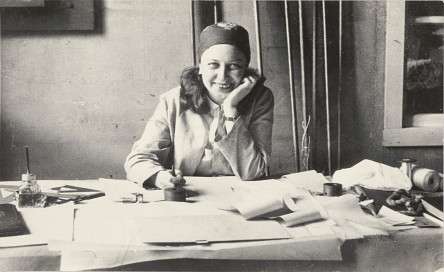

As a sole trader in Berlin in the early 1930s, textile designer Otti Berger created fabrics that fundamentally changed the understanding of what textiles could be and achieve. She designed upholstery fabrics, curtains, wall fabrics and floor coverings and worked closely with architects of the Neues Bauen movement such as Lilly Reich, Ludwig Hilberseimer and Hans Scharoun. Her designs impressively combine aesthetics, function and technical innovation. Otti Berger, who studied and taught at the Bauhaus in Dessau, worked for clients throughout Europe and acquired numerous patents.
In cooperation with the Bauhaus Archive, the artist Judith Raum and the weaver and textile designer Katja Stelz have analysed Otti Berger’s fabrics in a research project lasting several years. The interdisciplinary research process has resulted in a richly illustrated publication that makes Berger’s work comprehensively accessible for the first time. Judith Raum approaches Berger’s work by categorising the fabrics according to their functions and relationships to the architectural elements of furniture, windows, walls and floors. New colour photographs by Uta Neumann also show the beauty and sophistication of the textiles in a previously unknown way. (The publication “Otti Berger. Weaving for Modernist Architecture” (English, with German supplement), edited by Judith Raum and the Bauhaus-Archiv Berlin, is published by Hatje Cantz and costs 50 euros).
From 15 March, the “temporary bauhaus-archiv” will be showing an installation by Judith Raum, specially designed for the venue, which brings Otti Berger’s work to life through the senses. A video work and two large-format wall hangings woven especially for the exhibition refer to central aspects of Berger’s life and work, her efforts to obtain patent protection for her technically outstanding fabrics, and her professional and private fate as a Jew during the Nazi dictatorship. Otti Berger (1898-1944) was born in Zmajevac, in the then Hungarian Kingdom of Croatia. She studied in Zagreb from 1921 to 1926 and at the Bauhaus in Dessau from 1927. After teaching at the Bauhaus, she set up her own business in Berlin in 1932, designing fabric collections for modern interiors throughout Europe. In 1936, as a Jew, she was banned from working and tried unsuccessfully to escape to England and the USA. She was deported from Croatia to Auschwitz in 1944, where she was murdered.
More on ndion
Discover more articles on the topics of Design and People in Design.
Share this page on social media:

